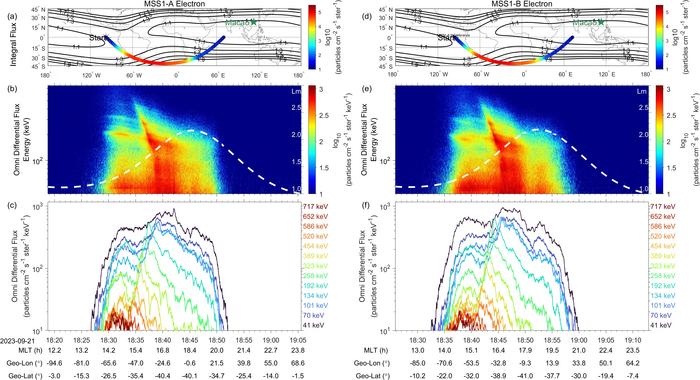In a groundbreaking study, researchers have unveiled observations of a peculiar phenomenon within the South Atlantic Anomaly (SAA), an area recognized for its unique geomagnetic characteristics and heightened flux of energetic particles. The study, conducted by an esteemed team led by Professor Zong from Peking University along with collaboration from the State Key Laboratory of Lunar and Planetary Science at the Macau University of Science and Technology, utilizes advanced instrumentation aboard the Macao Science Satellite – 1 (MSS-1). This project has notably enhanced our understanding of energetic electron dynamics, particularly in low-Earth orbit environments.
The MSS-1 is an innovative dual-satellite system designed to collect comprehensive data regarding the full pitch angle distribution of electrons at different altitudes. The satellite duo operates under distinct orbital configurations, with MSS1-A in a circular orbit at 450 kilometers, and MSS1-B maintaining an elliptical orbit between altitudes of 450 and 500 kilometers. This unique design enables researchers to gather high-precision measurements critical for assessing space weather phenomena, a growing concern as we increasingly rely on satellite technology.
One of the most striking discoveries from this research is the detection of a ‘wisp’ within the SAA, characterized by a spike in intensity that diverges from the established norms of electron precipitation. The SAA, a region where the Earth’s magnetic field is notably weaker, serves as a trap for energetic particles, posing challenges for satellites orbiting through this area. The appearance of the wisp is particularly significant as it suggests a complex interaction between the VLF (very low frequency) waves emitted from terrestrial sources and the energetic electrons in this hazardous region.
The research details how VLF waves, specifically those emanating from the NWC transmitter in Australia, can effectively scatter energetic electrons within the inner radiation belt to alter their pitch angles. Such scattering events lead to the formation of the wisp, which is typically observable outside the SAA, demonstrating minimal intensity in regions within the anomaly. The observation of a wisp inside the SAA, however, presents a stark contrast to traditional findings and raises important questions regarding the dynamics of particle precipitation in this unique space environment.
The team’s meticulous analysis reveals that the observed wisp within the SAA is likely attributed to a specific range of pitch angles situated just outside the drift loss cone—an insight made possible only through the advanced capabilities of MSS-1. This nuanced understanding differentiates between trapped and precipitating electron populations, allowing the researchers to derive a ratio indicating that approximately 2-5% of the trapped electrons can experience loss due to the scattering effect created by the VLF transmitter.
Adding to the intrigue, the researchers posit that the implications of their findings extend beyond mere observation; they provide a quantitative assessment of the VLF transmitter’s role in enabling electron pitch angle scattering. This has significant consequences for our understanding of space weather and its potential impacts on satellite operations and communication systems. The research confirms a profound connection between ground-based VLF emissions and the behavior of energetic particles in low-Earth orbit, signifying a pivotal advancement in the field of space science.
The extensive data gathered from both MSS1-A and MSS1-B allow for a detailed spectrogram analysis and electron flux mapping, revealing multiple facets of the electron behaviors in response to the dynamic influences of the SAA. The synthesis of these observations not only corroborates existing theories regarding energetic electron dynamics but also refines our approaches to modeling space weather phenomena that could jeopardize satellite functionality.
The implications of these discoveries are immense, pointing towards innovative approaches to mitigate the risks posed by space weather events. As we continue to explore the intricacies of our planet’s magnetosphere and its interaction with low-energy and high-energy particles, this study serves as a critical stepping stone towards enhanced safety for orbiting satellites and reliable communication systems.
By charting a new path in the investigation of energetic electron dynamics within the SAA, Professor Zong and his team have opened up a realm of possibilities for future research. The data generated by the MSS-1 satellites will undoubtedly spark further inquiries into the atmospheric physics governing space weather, with an emphasis on the influences of anthropogenic sources like VLF transmitters.
In conclusion, the observations made by the MSS-1 team not only expand our scientific understanding but also prompt a reevaluation of current models regarding particle dynamics in the SAA and other similar regions. In a landscape increasingly shaped by technological advancements, the implications of this research resonate deeply within the scientific community and offer a fresh perspective on the intersection of terrestrial activities and space weather phenomena.
This momentous study showcases how innovative satellite technology can lead to unforeseen discoveries in space science, highlighting the delicate balance between human-induced signals and their influence on outer space environments. As our reliance on satellite technology continues to grow, understanding and mitigating the impacts of space weather becomes ever more critical, ensuring the continued safety and functionality of our modern communications and navigation systems in increasingly complex space weather environments.
With the findings released in a forthcoming issue of Science China Earth Sciences, the research community eagerly anticipates ongoing developments stemming from this study, emphasizing the importance of continuous exploration in our quest to better understand the universe and our ever-evolving relationship with it.
Subject of Research: Observation of energetic electron ‘wisp’ within the South Atlantic Anomaly due to terrestrial VLF transmitter
Article Title: Radiation belt electron wisp inside South Atlantic Anomaly due to terrestrial VLF transmitter observed by MSS-1
News Publication Date: 2025
Web References: http://dx.doi.org/10.1007/s11430-024-1465-x
References: Sun, Y., Liu, Y., Zong, Q. et al. Radiation belt electron wisp inside South Atlantic Anomaly due to terrestrial VLF transmitter observed by MSS-1. Science China Earth Sciences, 68(2): 538–548 (2025)
Image Credits: ©Science China Press
Keywords: South Atlantic Anomaly, energetic electrons, Macao Science Satellite – 1, VLF waves, space weather, satellite technology




